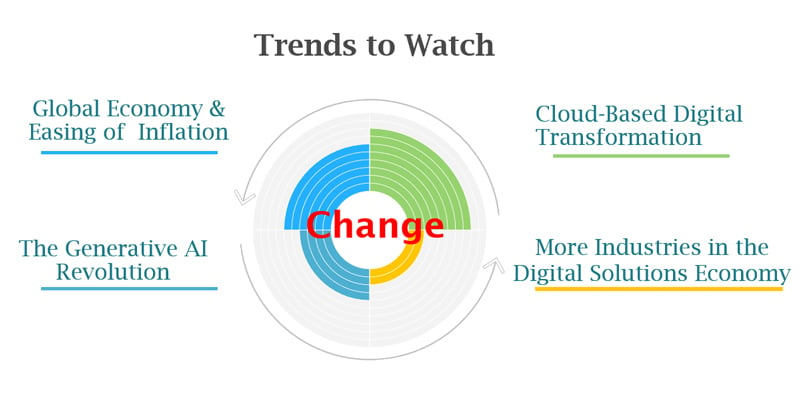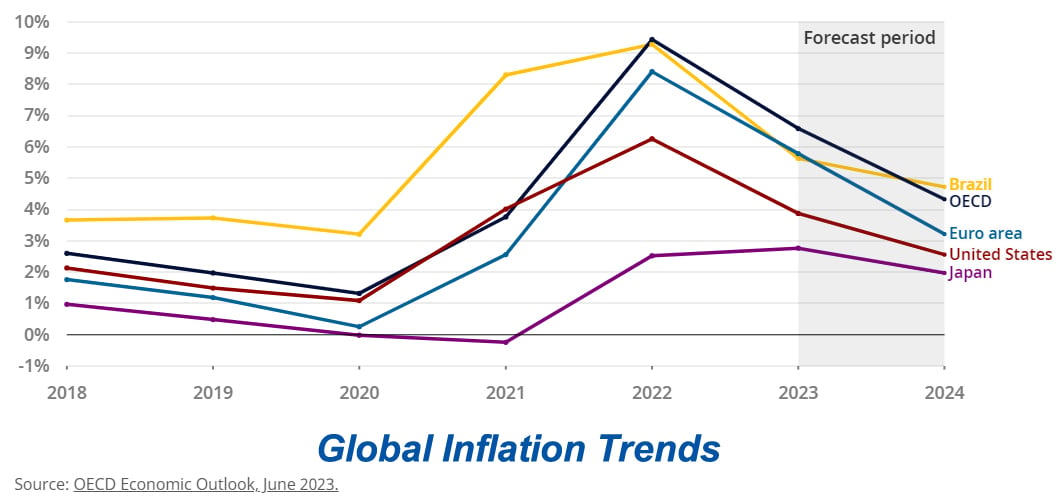As we reach the halfway point in 2023, it is a good opportunity to take another look at over-arching trends, both to update those we have already identified and to add some new ones, such as the unprecedented explosion in generative AI applications.
Below are four important topics to watch as we move into the rest of the year.
Global Economy May Have Seen the Worst of Inflation
According to the Organization for Economic Co-operation and Development (OECD), "Global GDP growth in 2023 is projected to be 2.7%, the lowest annual rate since the global financial crisis, with the exception of the 2020 pandemic period. A modest improvement to 2.9% is foreseen for 2024. Annual OECD GDP growth is projected to be below trend in both 2023 and 2024, although it will gradually pick up through 2024 as inflation moderates and real incomes strengthen."
Even though headline inflation has fallen in most economies in recent months due to the downturn in energy prices, food and services prices have continued to rise rapidly and core inflation remains stubbornly high. OECD projects that global headline inflation will moderate from 6.6% to 4.3% as we move through the rest of 2023 and 2024.
Despite the higher interest rates resulting from the Federal Reserve hikes to combat inflation, the US economy continues to show surprising resilience with GDP in Q1 2023 showing a 2% annual growth rate. This has been largely due to strong consumer spending which fuels about 70% of the US economy and rose at a 4.2% annual rate in Q1 2023.
Artificial Intelligence Revolution Extends into B2B
Although artificial intelligence applications such as machine learning (ML) and robotic process automation (RPA) already have been in wide usage for B2B (business-to-business) markets, the revolution spurred by new generative AI has added fuel to the enterprise adoption of artificial intelligence.

Here are some ways in which AI can transform B2B markets:
- Enhanced Decision-Making: AI can provide businesses with advanced analytics and predictive capabilities, enabling more informed decision-making. By analyzing large volumes of data and identifying patterns and trends, AI systems offers valuable insights for market analysis, customer segmentation, demand forecasting, and strategic planning.
- Smart Process Automation: AI-powered automation can streamline and optimize various B2B processes, leading to increased efficiency and cost savings. For example, RPA processes handling repetitive and rule-based tasks, such as data entry, document processing, and invoice reconciliation can be guided by new, higher level AI insights and learning capabilities.
- Customer Experience and Personalization: AI enables businesses to deliver personalized experiences to their B2B customers. By analyzing customer data and preferences, AI algorithms can provide tailored recommendations, personalized marketing campaigns, and optimized pricing strategies. Natural Language Processing (NLP) and chatbots can also enhance customer service by providing instant and personalized responses to queries and concerns.
- Supply Chain Optimization: AI can optimize supply chain management by analyzing data from various sources, including suppliers, inventory systems, and logistics. It can predict demand, optimize inventory levels, streamline logistics routes, and identify potential bottlenecks or disruptions. AI-powered systems can enable efficient supply chain planning, reduce costs, and improve overall operational resilience.
- Predictive Maintenance: AI can enhance maintenance practices in B2B industries by enabling predictive maintenance. By analyzing sensor data, historical maintenance records, and equipment performance, AI algorithms can predict when machinery or equipment is likely to fail. This proactive approach allows businesses to schedule maintenance tasks, reduce unplanned downtime, and optimize asset utilization.
These are just a few examples of how new AI capabilities can impact B2B markets. We will keep watching this space as AI continues to open new opportunities for businesses to drive innovation, improve efficiency, and gain a competitive edge in the B2B landscape.
Digital Solutions Economy is Disrupting More Industries
Another key trend that continues to drive waves of change across many industries is the move toward subscription, consumption, and usage based offerings in the Digital Solutions Economy (DSE). As more companies take advantage of the predictable recurring revenues and customer loyalty enhancements provided by DSE business models, it has become clear that a holistic approach is the only way to deliver front-end customer-facing flexibility combined with back-end scalability, profitability and compliance.
B2B offerings in the everything-as-a-service (XaaS) area are gaining speed and breadth across virtually all industry sectors. This insight aligns with what Bramasol has seen regarding impacts of DSE in telecom, media, electronics, software/SaaS, semiconductors, medical devices, transportation, energy, and utilities.
The key to success is to understand how the SAP Quote-to-Cash portfolio of applications (formerly known as BRIM) can be selectively deployed to leverage the best value and business results. In some cases, a full-stack deployment makes sense however in other scenarios, companies may be best served by combining one or more specific applications such as those shown below.
 Tailoring the best approach requires a clear understanding of the big picture use cases, such as piloting new subscription offerings, enhancing usage/consumption offerings or doing a full greenfield transformation. This big picture view needs to be coupled with a detailed knowledge of how to most efficiently implement those functional building block solutions that are most appropriate for your specific requirements.
Tailoring the best approach requires a clear understanding of the big picture use cases, such as piloting new subscription offerings, enhancing usage/consumption offerings or doing a full greenfield transformation. This big picture view needs to be coupled with a detailed knowledge of how to most efficiently implement those functional building block solutions that are most appropriate for your specific requirements.
Cloud-based Solutions Driving Digital Transformation
Cloud-based digital transformation has become a significant trend in recent years, and it continues to be the go-to approach that is shaping the business landscape across various industries.

Some of the important advantages for using a cloud-based methodology include:
- Scalability and Flexibility: Cloud computing offers organizations the ability to scale their resources up or down based on demand. This scalability enables businesses to adapt to changing market conditions, handle increased workloads, and accommodate growth without significant infrastructure investments.
- Cost Efficiency: Cloud-based solutions eliminate the need for large upfront investments in hardware and software infrastructure. Instead, organizations can access computing resources on a pay-as-you-go basis, reducing capital expenditures and shifting towards operational expenses. This cost-effective model allows businesses of all sizes to leverage advanced technologies without financial constraints.
- Enhanced Collaboration and Remote Work: The cloud provides a centralized platform for collaboration, enabling teams to work together efficiently irrespective of their physical locations. Cloud-based productivity tools, file sharing, and communication platforms facilitate seamless collaboration and remote work, leading to improved productivity and work-life balance.
- Agility and Innovation: Cloud computing empowers organizations to rapidly develop and deploy applications, reducing time to market for new products and services. By leveraging cloud-native technologies, businesses can innovate faster, experiment with new ideas, and embrace continuous improvement methodologies, such as DevOps and Agile, for more efficient software development and deployment cycles.
- Data Analytics and Insights: The cloud enables businesses to collect, store, and analyze vast amounts of data more effectively. Cloud-based data analytics platforms provide advanced tools and capabilities, including machine learning and artificial intelligence, to gain valuable insights and make data-driven decisions. This leads to improved customer experiences, optimized operations, and better business outcomes.
SAP's commitment to leadership in cloud-based digital transformation was highlighted during the Sapphire keynote by SAP CEO, Christian Klein, in which he discussed the comprehensive SAP cloud portfolio rooted in the Business Technology Platform (SAP BTP).
Leveraging the BTP platform, solutions such as the SAP Business Transformation Center and SAP Cloud Application Lifecycle Management (ALM) give companies comprehensive ways to transform their data and operations with seamless strategic control over every phase of the process.
Summary
From an overall perspective, this mid-year update on trends to watch underscores the fact that change is inevitable, relentless, continuous, and can have sweeping impacts for virtually every company across all industry segments.
At Bramasol, we have taken the approach that change is not only unavoidable; it is also full of opportunities to improve business operational efficiency and effectiveness by offering new ways to deepen customer engagement, unify end-to-end processes, expand market reach and enhance profitability.

For more information, check out these resources:
- Video: BRIM Quote-to-Cash Overview
- Podcast: SAP's Carla LeJeune on Optimizing Entitlement Management
- Podcast: SAP’s Pete Graham on Anything-as-a-Service and How SAP Enables XaaS
- Webinar video: Managing Entitlements in the Digital Solutions Economy
- Webinar video: Power Transition to DSE with SAP Cash and Treasury Management
- Webinar video: Automating Revenue Management for the Digital Solutions Economy
- eBook: Using DSE to Create Integrated, Scalable & Sustainable Business Models
- Four Key Insights from SAP Sapphire 2023


